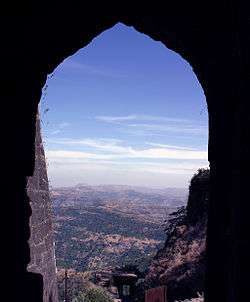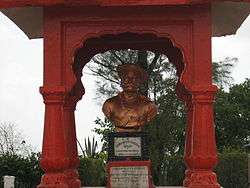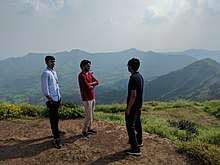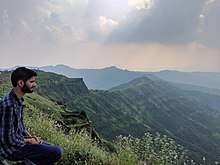Sinhagad
| Sinhagad Fort | |
|---|---|
| Part of maharashtra | |
|
Pune District, Maharashtra | |
|
Sinhgad fort entrance | |
 Sinhagad Fort Shown within Maharashtra  Sinhagad Fort Sinhagad Fort (India) | |
| Coordinates | 18°21′56.39″N 73°45′18.97″E / 18.3656639°N 73.7552694°ECoordinates: 18°21′56.39″N 73°45′18.97″E / 18.3656639°N 73.7552694°E |
| Type | Hill Fort |
| Height | 1312m(4304ft) |
| Site information | |
| Owner | Government of India |
| Controlled by |
|
Sinhagad (also known as Sinhgad) is a hill fortress located at around 36 km southwest of the city of Pune, India. Some of the information available at this fort suggests that the fort could have been built 2000 years ago. The caves and the carvings in the Kaundinyeshwar temple stand as proofs for the same.
Previously known as Kondhana, the fort had been the site of many battles, most notably the Battle of Sinhagad in 1670. Perched on an isolated cliff of the Bhuleswar range in the Sahyadri Mountains, the fort is situated on a hill about 760 metres above ground and 1,312 metres above mean sea level.
The Sinhagad (Lion's Fort) was strategically built to provide natural protection due to its very steep slopes. The walls and bastions were constructed only at key places. There are two gates to enter the fort, the Kalyan Darwaza and Pune Darwaza which are positioned at the south east and north-east ends respectively.[1] The fort was also strategically located at the centre of a string of other Maratha occupied forts such as Rajgad Fort, Purandar Fort and Torna Fort.
History

The Sinhgad Fort was initially known as "Kondhana" after the sage Kaundinya. The Kaundinyeshwar temple coupled with the caves and carvings indicate that the fort had probably been built around two thousand years ago. It was seized by Muhammad bin Tughlaq from the Koli in 1328 AD.

Shahaji Bhosale, as the commander of Ibrahim Adil Shah I, was entrusted with the control of the Pune region. His son Shivaji, refused to accept the Adilshahi and initiated the task of setting up Swarajya. Shivaji gained control of Kondana in 1647 by convincing Siddi Amber, the Adilshahi Sardar who controlled the fort, that he, the son of Shahaji Bhosale, could manage the fort's defences optimally. Bapuji Mudgal Deshpande played a key role in this activity. Adil Shah jailed Siddi Amber for this treasonous act and schemed to get it back. He imprisoned Shahaji Bhosale for a concocted crime and informed Shivaji. In 1649, Adil Shah traded the fort for Shahaji's release. Shivaji Maharaj recaptured it in 1656 again with the help of Bapuji Mudgal Deshpande who convinced the Fort commander by giving land in the newly created Shivapur village and peacefully gained control of the fort.
This fort saw attacks by Mughals in 1662, 1663 and 1665. In 1664, "Shahistekhan", a Mughal general, tried to bribe the people of the fort to hand it over to him, but was unsuccessful.
Through the Treaty of Purandar, the fort passed into the hands of the Mughal army chief "Mirzaraje Jaysingh" in the year 1665.
In 1670, Chhatrapati Shivaji Maharaj reconquered the fort for the third time and the fort came and stayed under the Maratha rule till 1689 A.D.
After the death of Sambhaji, the Mughals regained control of the fort. The Marathas headed by "Sardar Balkawade", recaptured it in 1693. Chatrapati Rajaram took asylum in this fort during a Mogul raid on Satara but died in the Sinhagad Fort on 3 March, 1700 A.D.
In 1703, Aurangzeb conquered the fort. In 1706, it once again went into the hands of the Maratha's. Pantaji Shivdev of Sangola, Visaji Chafar and the Pant Pratinidhis played a key role in this battle. The fort remained under the Maratha rule till the year 1818, after which the British conquered it. The British however took 3 months to capture this fort, which was longest it took them to win any fort in Maharashtra.
Battle of Sinhagad
.jpg)
One of the most famous battles on Sinhgad was fought by Tanaji Malusare, a general of Chhatrapati Shivaji of the Maratha Empire in order to recapture the fort on March 1670[2]

A steep cliff leading to the fort was scaled in the dead of the night with the help of a tamed monitor lizard named "Yashwanti", colloquially known as a ghorpad. Thereafter, A fierce battle ensued between Tanaji and his men versus the Mughal army headed by "Udaybhan Singh Rathod", a Rajput sardar who had control of the fort. Tanaji Malusare lost his life, but his brother "Suryaji" took over and captured the Kondana fort, now known as Sinhagad.[3]
There is an anecdote that upon hearing of Tanaji's death, Chhatrapati Shivaji expressed his remorse with the words, "Gad aala, pan Sinha gela" - "The Fort is conquered, but the Lion was lost".
According to some the name sinhagad predates this event.A bust of Tanaji Malusare was established on the fort in the memory of his contribution to the battle.[4]
Culture and Tourism



The Sinhagad Fort is a popular weekend destination for many residents of Pune, including trekking enthusiasts with access to the top of the fort from the base of the Sinhgad village. The trek involves a one-way walk of 2.7 km (1.6 miles) over which the walker gains about 600 m (1950 feet) in elevation.
Parts of the once extensive fortification are in ruins. The fort houses a memorial to Tanaji as well as the tomb of Rajaram Chhatrapati. Visitors can see the military stables, a brewery and a temple of goddess Kali (goddess) along with a Hanuman statue to the right side of the temple, as well as the historic gates.
Training exercises are carried out at the fort by cadets from the National Defence Academy at Khadakwasla. Cadets from the academy are regularly sent on hikes and runs from NDA to Sinhagad in full battle gear.
The fort also houses a television tower for broadcasting local TV signals. Currently, Non-Vegetarian food, Partying including alcoholic beverages and smoking is banned on the fort.[5][6]
The local municipal transport service runs buses every hour from "Shaniwarwada" and "Swargate" to the Sinhagad foothills at Donje village. The climbing route from either side of the fort can be covered in an hour. Shared taxi services to the base as well as the top of the mountain are also available.
References
- ↑ "Sinhagad Fort". Archived from the original on 2008-01-08. Retrieved 2012-05-18.
- ↑ Gordon, Stewart (1993). The Marathas 1600-1818 (1. publ. ed.). New York: Cambridge University. p. 70. ISBN 9780521268837.
- ↑ Sudheer Birodkar. "Chattrapati Shivaji Maharaj and the National Revival under the Marathas". hindubooks.org. Archived from the original on 30 September 2000.
- ↑ Verma, Amrit. Forts of India. New Delhi: The Director, Publication Division, Ministry of Information and Broadcasting, Government of India. pp. 83–86. ISBN 81-230-1002-8.
- ↑ "Archived copy". Archived from the original on 5 December 2015. Retrieved 3 September 2015.
- ↑ "Ban on partying on Sinhagad fort". TNN. The Times of India. 25 March 2015. Retrieved 4 July 2015.
See also
| Wikimedia Commons has media related to Sinhagad. |